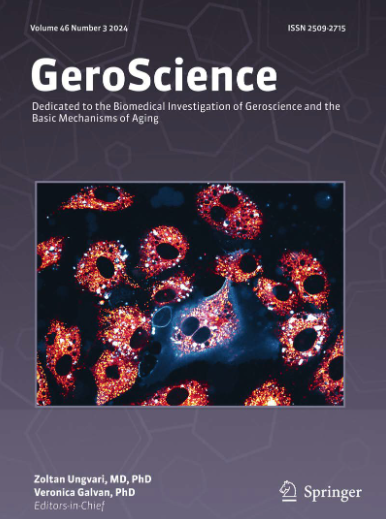BrainAGE in superagers: cross-sectional and longitudinal analyses in older adults aged 80+ with youthful episodic memory.
IF 5.4
2区 医学
Q1 GERIATRICS & GERONTOLOGY
引用次数: 0
Abstract
Episodic memory, the ability to recall past events, is particularly vulnerable to ageing. A decline in episodic memory performance is generally considered part of ageing. However, the episodic memory performance of superagers -defined as individuals aged 80+ years old with episodic memory of people 30 years younger- is superior to that typical of their chronological age. The aim of this study was to determine whether the discrepancy between the superager's episodic memory and chronological age is also evident in their brain age. A BrainAGE (Brain Age Gap Estimation) approach, a multidimensional computational neuroanatomical method that uses structural neuroimaging data to estimate biological brain age, was applied. The study population comprised 64 superagers (mean age = 81.9 ± 1.9) and 55 age-matched typical older adults (82.4 ± 1.9). Cross-sectional analyses revealed a negative BrainAGE score for superagers (mean = -0.95 ± 2.36) indicating a deceleration of the ageing process. By contrast, typical older adults showed an average score close to zero (0.05 ± 3.03) consistent with their chronological age. The BrainAGE score of superagers was found to be lower relative to typical older adults, and the progression over a 5-year follow-up period was slower in superagers, in keeping with their youthful memory ability. Therefore, superagers have a younger brain than those of typical older adults, suggesting that their ageing mechanisms may involve resistance to age-related brain structural changes. However, despite a 30-year gap in episodic memory, their BrainAGE score differed by only one year, indicating that factors beyond brain structure contribute to the superager phenotype.超级老年人的脑龄:80岁以上具有年轻情景记忆的老年人的横断面和纵向分析。
情景记忆,即回忆过去事件的能力,尤其容易受到年龄增长的影响。情景记忆能力的下降通常被认为是衰老的一部分。然而,超级老人的情景记忆表现——定义为80岁以上的人,他们的情景记忆比他们的实际年龄要小30岁——要好。这项研究的目的是确定超级老人的情景记忆和实足年龄之间的差异是否在他们的大脑年龄中也很明显。BrainAGE(脑年龄差距估计)方法是一种多维计算神经解剖学方法,使用结构神经成像数据来估计生物脑年龄。研究人群包括64名高龄老人(平均年龄= 81.9±1.9)和55名年龄匹配的典型老年人(82.4±1.9)。横断面分析显示,超级老人的BrainAGE得分为负(平均= -0.95±2.36),表明衰老过程的减速。相比之下,典型老年人的平均得分接近于零(0.05±3.03),与他们的实足年龄相符。研究发现,与典型的老年人相比,超级老人的BrainAGE得分较低,而且在5年的随访期间,超级老人的进展较慢,这与他们年轻的记忆能力相符。因此,超级老人的大脑比典型的老年人更年轻,这表明他们的衰老机制可能与抵抗与年龄相关的大脑结构变化有关。然而,尽管情景记忆有30年的差距,但他们的BrainAGE得分只相差1年,这表明大脑结构之外的因素导致了超级老人的表型。
本文章由计算机程序翻译,如有差异,请以英文原文为准。
求助全文
约1分钟内获得全文
求助全文
来源期刊

GeroScience
Medicine-Complementary and Alternative Medicine
CiteScore
10.50
自引率
5.40%
发文量
182
期刊介绍:
GeroScience is a bi-monthly, international, peer-reviewed journal that publishes articles related to research in the biology of aging and research on biomedical applications that impact aging. The scope of articles to be considered include evolutionary biology, biophysics, genetics, genomics, proteomics, molecular biology, cell biology, biochemistry, endocrinology, immunology, physiology, pharmacology, neuroscience, and psychology.
 求助内容:
求助内容: 应助结果提醒方式:
应助结果提醒方式:


